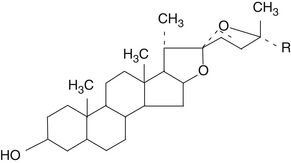Chapter 121 Sarsaparilla Species
Smilax aristolochiifolia (family: Liliaceae)
Common name: Mexican sarsaparilla
Smilax chinensis (family: Liliaceae)
Common name: Chinese sarasaparilla
Smilax officinalis (family: Liliaceae)
Common name: Honduras sarsaparilla
 Chemical Composition
Chemical Composition
Sarsaparilla contains 1.8% to 2.4% steroid saponins, including the following:
Other constituents are starch, resins, polyphenols (stilbenes, including resveratrol), flavonoids, and a trace of volatile oil.1–3
 History and Folk Use
History and Folk Use
Smilax species are distributed widely in tropical and temperate regions throughout the world and have been used in many different cultures for the same conditions—namely gout, arthritis, fevers, digestive disorders, skin disease, and cancer.1 From a historic perspective, sarsaparilla’s medicinal use has been as a tonic and blood purifier. Tonics are defined as agents that “permanently exalt the energies of the body at large, without vitally affecting any one organ in particular. In short, tonics tone the whole system. A blood purifier or depurative [is] an agent that cleanses and purifies the system.”4 Sarsaparilla’s reputation in this regard probably stems from its importation from the Caribbean and South America to Europe in the sixteenth century for the treatment of syphilis.5
Historic Use in the Treatment of Syphilis
Nicholas Monardes, a French physician, published a comprehensive account of sarsaparilla and several other “new” drugs for the treatment of syphilis in 1574. Many Europeans at the time believed that syphilis had come to Europe from the West Indies, with Columbus’ sailors. Because there was a general belief that whatever disease was native to a country might be cured by the medicinal herbs grown in that region, it was only natural for sarsaparilla to become a popular remedy. Furthermore, use of the standard treatment for syphilis, mercury, often resulted in greater morbidity and mortality than the disease itself.
Sarsaparilla was a welcome alternative, but despite initial excitement, Monardes’ sarsaparilla cure sank in favor. This was probably because of other aspects of the cure, which involved confinement to a warm room for 30 days, followed by 40 days of abstinence from both wine and sexual intercourse.5
However, sarsaparilla continued to be used in the treatment of syphilis. During military operations in Portugal in 1812, a British inspector general of hospitals noted that the Portuguese soldiers suffering from syphilis who used sarsaparilla recovered much faster and more completely than their British counterparts, who were treated with mercury.5
Sarsaparilla was also used by the Chinese in the treatment of syphilis. Clinical observations in China show that sarsaparilla was effective, according to blood tests, in about 90% of acute cases and 50% of chronic cases.1,6
Although sarsaparilla was clearly more beneficial than mercury in the treatment of syphilis, it was mercury that established itself as the standard treatment for more than 4½ centuries. It has been stated that “the use of mercury in the treatment of syphilis may have been the most colossal hoax ever perpetrated” in the history of medicine.5 Mercury represented a new kind of medicine, one formulated and prepared in a laboratory using the new techniques of chemistry. It helped prepare the way for the future use of drugs rather than herbal medicines.
Stay updated, free articles. Join our Telegram channel

Full access? Get Clinical Tree



